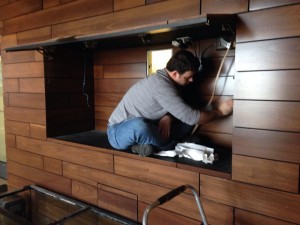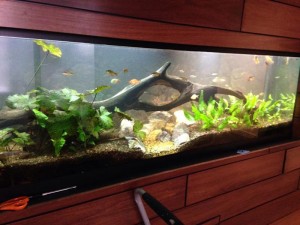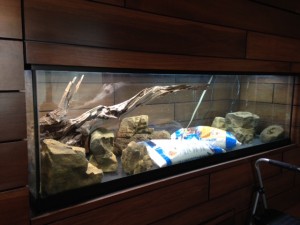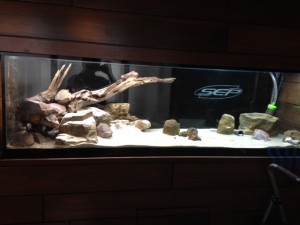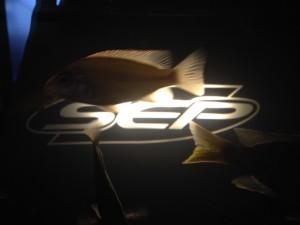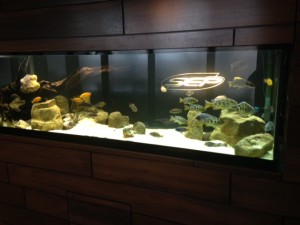SEP History Lesson: When an Enthusiastic Newbie Convinced Us to Get a Fish Tank
I’ve had several people tell me they liked the new fishtank design (thank you!), and it was suggested that I do a write-up about the tank. I’m always happy to talk about it! I’ll start with some history…
How it Began
It all started around 10 years ago. I was interviewing for a position at SEP, and we were going through “The List”. The List is an excercise where the candidate (me) lists out everything they want in a job and the recruiters at SEP talk through each item on “The List” to help determine if SEP is a good Fit for the candidate. My list had all the standard stuff – interesting and challenging work, nice coworkers, flexible schedule, fair pay, etc. When we were about to wrap up, I said, “There’s one more thing. I’d like to set up a fishtank in your lobby.” The recruiters seemed a little taken aback, but they said, “Well… sure – that’d be cool!”. No offense to them, but I never believed they were actually serious.
On my first day at SEP, our CEO Jeff Gilbert stopped by to say “hi” and asked me, “So. When can you set up the fishtank?”. I tentatively asked, “What’s my budget?”. He smiles, chuckles, and says, “Be reasonable.” And so I was. I found a used 110 gallon Oceanic online that I had to pick up in Illinois. I made an SEP logo with hand-cut stencils and spraypaint, and I got great deals on all the gear to go in it thanks to friends at the Circle City Aquarium Club. I would spend evenings after work rearranging the plants, cleaning the glass, and running 100 feet of hose down the hallway to do water changes. I loved it.
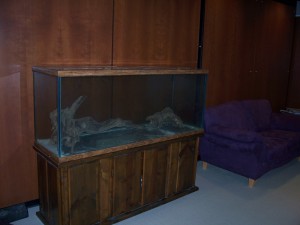 The tank started off wood-grain, but I updated it to black. The glass coffee table that used to be in front of that couch was an unfortunate casualty of the moving process.
The tank started off wood-grain, but I updated it to black. The glass coffee table that used to be in front of that couch was an unfortunate casualty of the moving process.
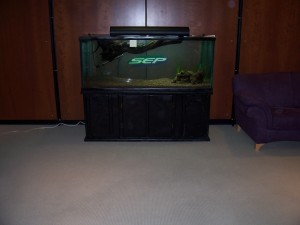 This was taken just after the tank was filled. I had not yet found a 5′ light to fit the tank, and the driftwood hadn’t water-logged yet.
This was taken just after the tank was filled. I had not yet found a 5′ light to fit the tank, and the driftwood hadn’t water-logged yet.
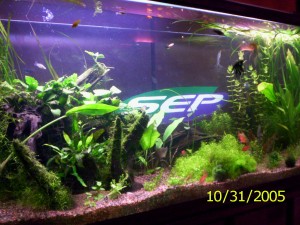 Things are starting to grow in nicely.
Things are starting to grow in nicely.
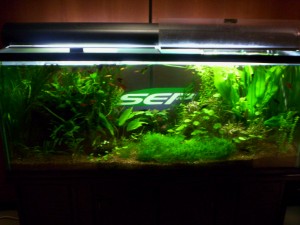 Sometimes things would grow in TOO nicely and I would need to judiciously trim back the plants before they eclipsed the logo!
Sometimes things would grow in TOO nicely and I would need to judiciously trim back the plants before they eclipsed the logo!
New Tank – Bigger and Better
After a few years, SEP grew too big for the office and we had to find a new location. We hired a few different designers to pitch layouts for the new place, and even without us asking for it, every single one of them had a fishtank in the design. I upgraded a little from the 5′ 110 gallon to a much easier to work with 6′ design (good luck trying to find 5′ light bulbs!) that holds 125 gallons. The 125 is now built into the wall, and let me tell you – if there’s ever a tornado then the safest place would be under the tank! It is all solid steel reinforced and super strong. It has been very fun deciding how to set up the new tank.
At first I chose a setup which involved lots of plants and some very pesky driftwood. The piece was beautiful but it WOULD NOT SINK. I ended up bolting it to ceramic tile, covering those tiles in substrate, and then putting a brick on them to hold it down. Four years later when I took it out, it was still floating. I liked the “riverbed” look I created with the lighter colored gravel path, but unfortunately the faux stone background was too thick (3″ min) and I felt like it took up too much room front to back, making the tank lack the depth I was going for.
This was a community tank. As I added fish, some would die off, and it ended up being a hodge podge of critters that really didn’t go together. The plants were the same way. Originally I had Valisneria sp. along the back but it wasn’t growing in nicely. Then my PC lights burned out so I swapped them for T5s and my Cryptocorynes really didn’t take off (probably due to shallow gravel thanks to that pesky driftwood!). Granted, there were some really nice fish in there. I had two full grown roseline barbs (Puntius denisonii) and a Leporinus fasciatus that was an office favorite. The school of Brilliant Rasboras looked better than I would have imagined.
Now for Something Different
Along came the opportunity to buy a full 75 gallon setup, including fish, from a member of the aquarium club. It was too good of a deal to pass up, and so it ended up in my living room. I fell in love with the fish – African cichlids, from Lake Malawi. I had never kept African cichlids before. They had so much personality, so much color – the blues and yellows and purples. It got me thinking about the tank at work. Over the years I’ve gotten various feedback from coworkers, a lot of it along the lines of, “Have you thought of doing saltwater?”. I know from working in petstores that people love critters with “color”. Gray and brown don’t count. That’s not to say feedback was always negative – many people have told me how much they like having a tank in the office – but these fish got me itching to try something new.
Inland Aquatics, one of the most amazing aquarium shops EVER, had just opened a branch in Indianapolis. I worked at the original store in Terre Haute all through college, so when I decided to find a new home for the fish from the 125, Morgan Lidster (the owner) was happy to help me out. They are now living happily at the store in Terre Haute, and I know Morgan will take great care of them. I drew up some quick and dirty concept art after I had found homes for the fish, and down came the tank! I scooped out five 5-gallon buckets of muddy gravel, bagged up all my plants, and took out the offending foam background. Ahhh, a clean slate!

The Hardware
Morgan set me up with the aragonite sand and rocks for the new setup. Aragonite is crushed coral, mostly calcium carbonate, which lends buffering capacity to the water. African cichlids need water with a high pH and hardness, which is convenient because the water that comes from Indiana is basically pulled through 50 feet of limestone before hitting the tap. It is liquid rock, and they love it. The decorative rocks in the tank may look massive, but many of them are reproductions – actually made of resin and hollow inside. This makes me a lot less nervous about the weight being put on the bottom glass. The driftwood is the original piece from the old office’s 110 gallon. It has been sitting in my garden since that tank was torn down. At least I know this piece will eventually sink!
The background is a stick on vinyl that we had custom made. It is a layer of black with the logo cut out, and then a layer of “frosted” vinyl over top. It took about 2 hours of professional installation to get all the bubbles out. The backlight for the logo is an LED fixture held on to the back wall with Command strips (best thing since sliced bread). It looks awesome at night with nothing but the SEP logo glowing!
The tank is lit by two double T5 fixtures and runs about 8 hours a day. Filtration for the tank is provided by an Ehiem ProIII canister filter, an AquaClear 110 HOB filter, and two large sponge filters driven by powerheads. I do a 50% water change every 1.5 weeks or so, to keep the water clean and the fish happy. There is a janitor’s closet behind the tank and so all I have to do is run some hoses through an opening in the wall – only takes about 40 minutes all told!
The Software
There are probably about… oh, maybe 30 fish in there, ranging from 2″ to about 6″. The cichlids are a mixture of mbuna (um-boo-na) which are shoreline rock-dwellers from Lake Malawi, and Haps, which prefer the open waters and sandy bottoms of the lake. I have venustus, blue dolphins, yellow-tail aceii, yellow labs, lwanda peacocks, a lone frontosa (from Lake Tanganyika, I’d take him out if I could catch him), and a couple others that I’m not 100% sure of the id on. One awesome thing about these cichlids is that they are all mouthbrooders – that is, the eggs are laid and fertilized and then the female will scoop them up and hold them in her mouth until the eggs hatch. It wouldn’t surprise me to see a female with a mouth full of babies in the tank before too long.
Cichlids are generally considered “aggressive” but there are a few things that help cut down on aggression. You might notice there are a lot of fish in there – that’s by design. Any aggression gets distributed over more bodies, so there is less likelyhood of having any one fish get picked on to death. This high bio-mass is compensated for by over-filtration and lots of water changes. There are also plentiful hiding places for a quick escape. I feed them cichlid pellets (from Ken’s Fish) and spirulina waffers. Ideally this happens several times a day, which also helps keep everyone from being grumpy.
There are a few other critters in there. I have several Ancistrus sp. catfish. These are sort of like the common “Plecostomus” except that they don’t get gigantic. They will suck onto the glass and help keep algae at bay. The males, when mature, get a face full of “bristles” which is why they are sometimes called bristle-nose plecos. There are also two Synodontis eupterus in there, and a raphael catfish who makes rare appearances.
What’s Next
Eventually I’d like to get some Synodontis petricola. These also live in Lake Malawi and they take advantage of the cichlid’s breeding habits to benefit their own offspring. They spawn at the same time as the cichlids, tricking the female cichlid into scooping up some catfish eggs along with her own. The baby catfish hatch first and outcompete the baby cichlids. There are so many interesting behaviors that I look forward to seeing from this new setup. I’ll probably add another circulation powerhead to keep the sand looking cleaner, and I may swap out the Aquaclear 110 for an Aqueon 75/55. It could probably also use another bag of aragonite sand. I’ll be rearranging the rockwork slightly once the driftwood is waterlogged, and it wouldn’t surprise me if I can’t resist adding some live plants.
Much like previous incarnations of the SEP fishtank, I’m sure this one will evolve as I learn more. Five years from now it could, and probably will, look totally different. Who knows, maybe in five years we’ll be in an even bigger office and I’ll get to upgrade to a 220…
If you ever have any questions about the setup, if you feel like talking about fish (I know this great club in town…) or if you’d just like the opportunity to throw some pellets in there and watch the fish frenzy – just let me know! I’m in the very fortunate position to get to enjoy a hobby I love while contributing to making my work environment a little brighter and more enjoyable. I’m glad I decided to take a chance in adding a fishtank to my version of “The List”, and I’m glad SEP took a chance and let me set it up!
